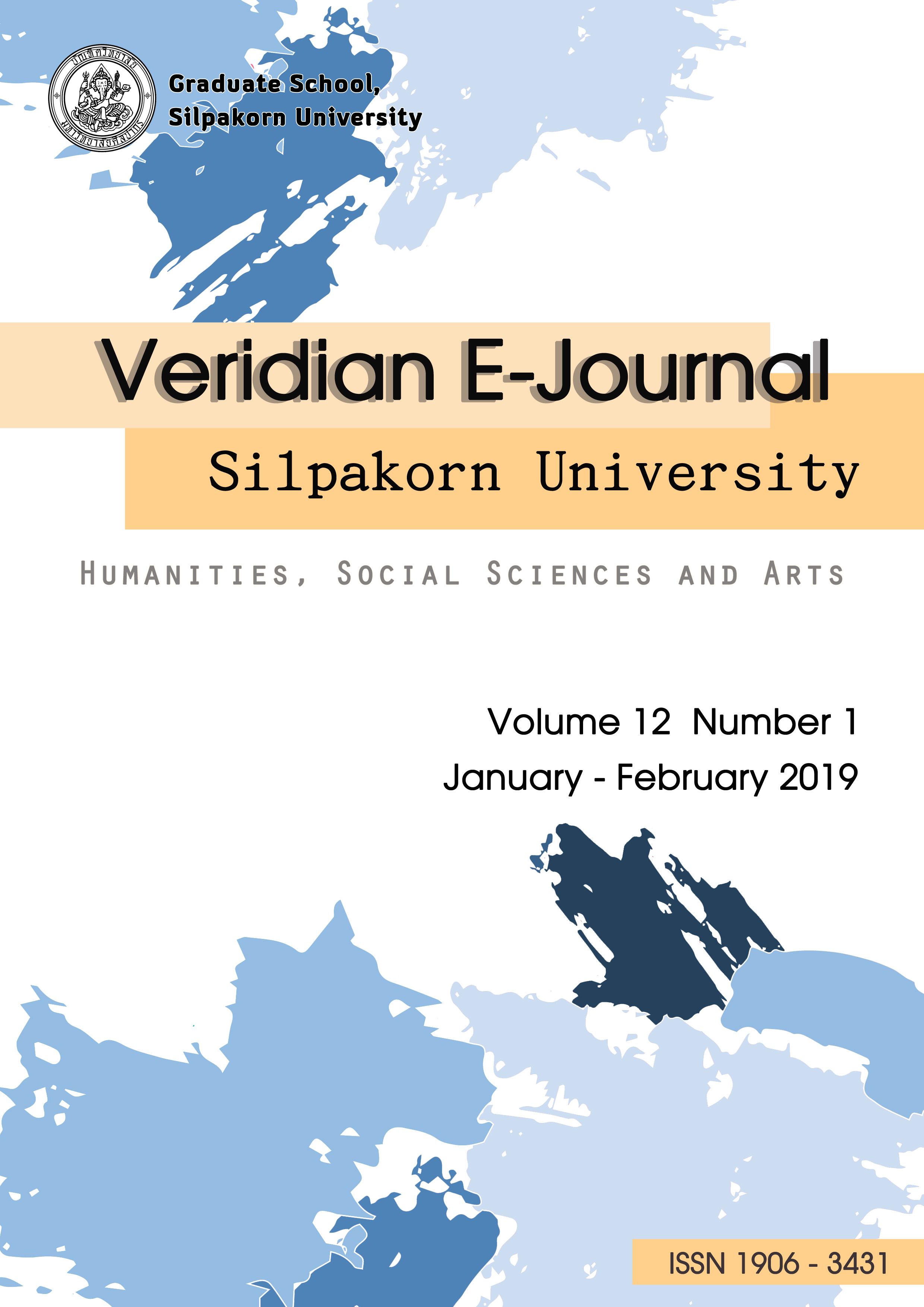การพัฒนารูปแบบการสนทนาในคอมพิวเตอร์สนับสนุนการเรียนรู้ร่วมกันตามแนวคิดสุนทรียสนทนาเพื่อส่งเสริมพฤติกรรมเชิงนวัตกรรมสำหรับภาคีเครือข่ายสุขภาพ (Development of Chat Model in Computer-Supported Collaborative Learning Based on Dialogue Concept to Enhance Innovative Behavior for Public Health Alliance)
Main Article Content
Abstract
การวิจัยในครั้งนี้มีวัตถุประสงค์ 2 ประการ คือ (1) เพื่อพัฒนารูปแบบการสนทนาในคอมพิวเตอร์สนับสนุนการเรียนรู้ร่วมกันตามแนวคิดสุนทรียสนทนาเพื่อส่งเสริมพฤติกรรมเชิงนวัตกรรมสำหรับภาคีเครือข่ายสุขภาพ 2) เพื่อศึกษาผลการใช้รูปแบบการสนทนาในคอมพิวเตอร์สนับสนุนการเรียนรู้ร่วมกันตามแนวคิดสุนทรียสนทนาฯ โดยการศึกษาผลการใช้รูปแบบการสนทนาในคอมพิวเตอร์สนับสนุนการเรียนรู้ร่วมกันตามแนวคิดสุนทรียสนทนาฯ แยกออกเป็น 2 ประเด็น ได้แก่ (1) การเปรียบเทียบพฤติกรรมเชิงนวัตกรรมของภาคีเครือข่ายสุขภาพก่อนทดลอง ระหว่างทดลอง และหลังทดลอง (2) การศึกษาความคิดเห็นของกลุ่มตัวอย่างต่อการเรียนด้วยรูปแบบการสนทนาในคอมพิวเตอร์สนับสนุนการเรียนรู้ร่วมกันตามแนวคิดสุนทรียสนทนาฯ ที่ส่งเสริมพฤติกรรมเชิงนวัตกรรมที่แตกต่างกัน กลุ่มตัวอย่างที่ใช้ในการทดลอง คือ ภาคีเครือข่ายสุขภาพในโครงการหลักสูตร TRC e-learning สนับสนุนโดยศูนย์วิจัยและจัดการความรู้เพื่อการควบคุมยาสูบ จำนวน 30 คน เก็บรวบรวมข้อมูลโดยมี 2 เครื่องมือ ได้แก่ (1) แบบวัดพฤติกรรมเชิงนวัตกรรมก่อนทดลอง ระหว่างทดลอง และหลังทดลอง และ (2) แบบสอบถามความคิดเห็นต่อการเรียนด้วยรูปแบบการสนทนาในคอมพิวเตอร์สนับสนุนการเรียนรู้ร่วมกันตามแนวคิดสุนทรียสนทนาฯ วิเคราะห์ข้อมูลโดยใช้สถิติ Repeated Measured Anova โดยกำหนดระดับนัยสำคัญที่ระดับ .05
ผลการวิจัยพบว่า (1) รูปแบบการสนทนาที่พัฒนาขึ้นมีทั้งหมด 4 ขั้นตอน คือ 1) ขั้นการทำความรู้จักสร้างความคุ้นเคย 2)ขั้นการใช้ความชำนาญในการสนทนาด้วยทรัพยากร 3) ขั้นการรับสิ่งสะท้อนการสนทนา และ 4) ขั้นการสนทนาแนวคิดสู่การปฏิบัติ และ (2) ผลการทดลองใช้รูปแบบการสนทนาภาคีเครือข่ายสุขภาพพบว่า คะแนนพฤติกรรมเชิงนวัตกรรมโดยรวมระหว่างการทดลอง ( =3.24) สูงกว่าก่อนการทดลอง (
=1.80) อย่างมีนัยสำคัญทางสถิติที่ระดับ .05 คะแนนพฤติกรรมเชิงนวัตกรรมโดยรวมหลังการทดลอง (
= 3.68) สูงกว่าก่อนการทดลอง (
=1.80) อย่างมีนัยสำคัญทางสถิติที่ระดับ .05 คะแนนพฤติกรรมเชิงนวัตกรรมโดยรวมหลังการทดลอง (
= 3.68) สูงกว่าระหว่างการทดลอง (
=3.24) อย่างมีนัยสำคัญทางสถิติที่ระดับ .05
The purposes of this research were: 1) to develop a chat model in computer-supported collaborative learning; and 2) to study the effect of the use of the chat model in computer-supported collaborative learning in order to enhance innovative behavior for Public Health Alliance. The results of the study were divided into 2 issues, namely, the comparison of the innovative behavior of the Public Health Alliance participants between before and after the experiment, and the study of the samples' opinions on the learning style which show different approaches on innovative behavior. The sample group comprised 30 persons of the health network partner in the TRC e-learning program sponsored by the Tobacco Control Research and Knowledge Management Center. The research instruments were (1) measurement of innovative behaviors before and during the experiment, and (2) questionnaire on learning based on dialogue concept. The Statistics employed for analysis were Repeated Measured ANOVA with the significant determination of .05 point.
The findings can be summarized as follows: (1) there are 4 steps in developing the chat model, namely, 1) the commencement of the dialogue in order to create familiarity, 2) the skill in continuing the dialogue by using resources, 3) the reflection of the dialogue and 4) the realization of the idea into practice; and (2) the results of the experiment using the Health Networking Chat Group model showed that total score of innovative behavior during experiment ( =3.24) was significantly higher than the one before the experiment (
=1.80) by .05 point. The overall innovative behavior after the experiment (
= 3.68) was significantly higher than the one before the experiment (
=1.80) by .05 point. The overall innovative behavior after the experiment (
= 3.68) is significantly higher than the one during experiment (
=3.24) by .05 point.
Article Details
References
กระทรวงดิจิทัลเพื่อเศรษฐกิจและสังคม.(2560). ข่าวกระทรวง. ค้นเมื่อ 22 พฤศจิกายน พ.ศ. 2560, จาก
https://www.mdes.go.th/view/1/%E0%B8%82%E0%B9%88%E0%B8%B2%E0%B8%A7%E0%B8%81%E0%B8%A3%E0%B8%B0%E0%B8%97%E0%B8%A3%E0%B8%A7%E0%B8%87%E0%B8%AF/%E0%B8%82%E0%B9%88%E0%B8%B2%E0%B8%A7%E0%B8%81%E0%B8%A3%E0%B8%B0%E0%B8%97%E0%B8%A3%E0%B8%A7%E0%B8%87/2810/.
Trīthip B.(2011). patčhai chœ̄ng sāhēt phahu radap thī mī ʻitthiphon tō̜ phrưttikam sāng
nawattakam radap bukkhon læ radap klum ngān phư̄a sāng nawattakam phalittaphan nai bō̜risat ʻēkkachon khō̜ng Thai . witthayāniphon parinyā dutsadī bandit . Mahāwitthayālai Sīnakharinwirōt .
ตรีทิพ บุญแย้ม. (2554). ปัจจัยเชิงสาเหตุพหุระดับที่มีอิทธิพลต่อพฤติกรรมสร้างนวัตกรรมระดับบุคคล
และระดับกลุ่มงานเพื่อสร้างนวัตกรรมผลิตภัณฑ์ในบริษัทเอกชนของไทย. วิทยานิพนธ์ปริญญาดุษฎี
บัณฑิต. มหาวิทยาลัยศรีนครินทรวิโรฒ.
Sīthīan T.(2014). suntharīya sonthanā : sāng san panyā ton : The Creation of Human
Wisdom . wārasān phayābān sāt læ sukkhaphāp ( Journal of Nursing Science and Health ) , sāmsipčhet ( sām ) , nưngrō̜isāmsipsō̜ng - 139.
ศรีเทียน ตรีศิริรัตน์.(2557). สุนทรียสนทนา: สร้างสรรปัญญาตน: The Creation of Human
Wisdom. วารสารพยาบาลศาสตร์และสุขภาพ (Journal of Nursing Science and
Health), 37(3), 132-139.
Sujitra T.(2012). kānphatthanā sapphayākō̜n manut . phimpha khrang thī 7. Krung Thēp :
khana rat pra sātsana sāt sathāban bandit phatthana bō̜rihān sāt .
สุจิตรา ธนานันท์. (2555). การพัฒนาทรัพยากรมนุษย์. พิมพ์ครั้งที่ 7. กรุงเทพฯ: คณะรัฐประศาสน
ศาสตร์สถาบันบัณฑิตพัฒนบริหารศาสตร์.
Wasan S. & Phithak S.(2015). khwāmpen nawatkō̜n thāngkān sưksākhan phư̄nthān nai
phāk rat : kānsưksā thritsadī thānrāk . Veridian E - Journal chabap
manutsayasāt sangkhommasāt læ sinlapa pǣt ( Phrưtsaphākhom Singhākhom ) :
sō̜ngrō̜ipǣtsipʻet - 300.
วสันต์ สุทธาวาศ และ พิทักษ์ ศิริวงศ์.(2558). “ความเป็นนวัตกรทางการศึกษาขั้นพื้นฐานในภาครัฐ:
การศึกษาทฤษฎีฐานราก”. Veridian E-Journal, Silpakorn University. ฉบับมนุษยศาสตร์
สังคมศาสตร์ และศิลปะ ปีที่ 8, ฉบับที่ 2 ( พฤษภาคม – สิงหาคม ): 281-300.
Visit W.(2005). Sunthō̜n yī sonthanā . krung thēp : sūan ngœ̄n mī mā .
วิศิษฐ์ วังวิญญู.(2548). สุนทรยี สนทนา. กรุงเทพ: สวนเงินมีมา.
ภาษาต่างประเทศ
Allaymoun, M. H., & Trausan-Matu, S. (2016). Analysis of collaboration in CSCL chat
using rhetorical schemas. In Information and Communication Systems (ICICS). 2016 7th International Conference on (pp. 39-44). IEEE.
Gibbons, A. (1997). Innovation and the Developing System of Knowledge Production.
University of Sussex
Isaacs, W. (2008). Dialogue: The art of thinking together. Crown Business.
Lukes, M., & Stephan, U. (2017). Measuring employee innovation: a review of existing
scales and the development of the innovative behavior and innovation support inventories across cultures. International Journal of Entrepreneurial Behavior & Research, 23(1), 136-158.
Schein, E. H. (1993). On dialogue, culture, and organizational learning. Organizational
dynamics, 22(2), 40-51.

